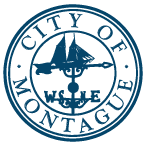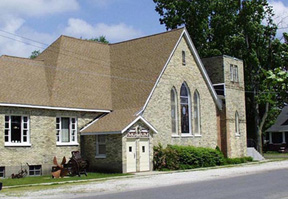Montague Museum
The Montague Museum is located at 8717 Meade Street on the corner of Meade and Church Streets, one block south of the top of the Town (Dowling Street) Hill.
Museum is open Saturday and Sunday from 1 pm to 5 pm, Memorial Day thru Labor Day. Individuals and special groups may request a guided tour by contacting the Montague City Hall at 231-893-1155. Leave a detailed message and include a phone number where you can be reached. A museum volunteer will call and make arrangements.
The Montague Museum resides in the former United Methodist Church. The building was originally constructed in 1872 and was sold to the Museum Board for a small sum in 1969. It features beautiful stained glass windows, red carpeted aisles, and a stereo system that provides pleasant browsing music. The museum exists today thanks to many hours of volunteer service and the continued generosity of numerous donors.
A Brief History of Montague
by the White Lake Chamber of Commerce
Located on the northwest edge of White Lake, and connected to its sister city Whitehall by a causeway, Montague is an example of small town America in a delightful setting. The shores of Lake Michigan are only four miles west of the center of town. Visitors enjoy the attractions of a small and large lake, boating, fishing, swimming and broad sandy beaches. The town has about 2,500 residents and is surrounded by fertile farmland and wooded areas.
Like many communities along the Eastern Shores of Lake Michigan, Montague began as a lumbering town. White pine and hardwoods were floated down the White River, to be cut up at sawmills on the lake and shipped to Chicago and other growing industrial cities in the country’s heartland. This became much easier when the government constructed a waterway, still known as the “New Channel,” in 1870 to replace the “Old Channel,” the natural but twisting and narrow outlet.
Noah Ferry laid out the plan for Montague in 1861 and named it after his father, William Montague Ferry. When a post office was established in 1867, Montague’s actual history began. Several significant buildings survive from this early lumbering period, among them the Rowe House from 1873, and the Ferry Church, built in 1874 in Noah Ferry’s memory after he was killed at Gettysburg in 1863. One symbol of the town is the Ella Ellenwood, a Montague lumbering schooner that was sunk in a storm in 1901 near Milwaukee. So the story goes, part of the ship’s wooden nameplate broke off and floated back across the lake, to be later found on the beach near Montague, suggesting that the ship had “come home.” The nameplate is preserved in a display case at Montague’s town hall and the schooner appears as part of the town shield.
As lumbering began to dry up in the late 1800s and early 1900s, farming and a few small foundries became the mainstays of a diminished economic base. One of those foundries, Whitehall Products, began operating in 1941 and has become the world’s premier maker of weathervanes. They built and erected the world’s largest functioning weathervane on a Montague waterfront mole jutting out into White Lake. Since the 1950s there have been a steady growth of both the manufacturing and tourism industries, slow enough so the small town atmosphere is preserved yet rapid enough to establish a solid economy.
The town has an excellent school system, a thriving farmers’ market and fine parks, including a band shell where summer concerts take place and Medbery Park on the north side of the “New Channel,” the reconstruction of which was just completed in 1998. The story of Montague would not be complete without making mention of Nancy Fleming, who was chosen to be Miss America in 1961. Her dress, along with many interesting mementos from bygone years, can be viewed at the Montague town museum.

